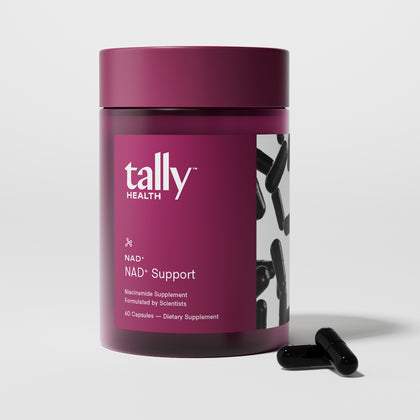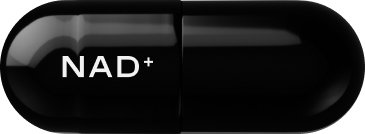

Most people think of NAD+ as a molecule for boosting energy, metabolism, and cellular longevity. And they’re not wrong. But that’s only part of the story.
NAD+ is a coenzyme involved in hundreds of biological processes, many of which also impact the health and appearance of your skin. It helps maintain cellular health within the skin barrier. It supports DNA repair in cells exposed to UV. It may even smooth lines and wrinkles. However, when NAD+ declines with the aging process, your skin doesn’t just age faster, it also stops functioning the way it should.
That’s why our new NAD+ supplement features niacinamide (also known as nicotinamide), a thoroughly studied, flush-free form of vitamin B3 (also known as niacin) shown to help restore NAD+ levels and support skin health where it starts: beneath the surface. Niacinamide, a B vitamin, acts as a precursor to NAD+ , making it a popular ingredient in serums aimed at rejuvenating the skin. But we’ve only scratched the surface — let’s dive deeper into the science.

Support skin aging | The benefits of NAD
Your skin is constantly renewing, repairing, and defending against environmental stressors, but it can’t do this without NAD+ . This coenzyme fuels processes that keep skin firm, resilient, and youthful. The potential benefits of NAD+ therapies also include a reduction in inflammation and improvements in chronic skin conditions like eczema and psoriasis.
Repairs UV damage
NAD+ powers enzymes that repair DNA damage caused by sun exposure and pollution—two major contributors to premature skin aging [1, 2]. The NAD+ precursor, niacinamide, has also been shown to inhibit inflammatory markers in skin cells exposed to UV radiation [3]. Preliminary research suggests that NAD+ may help repair UV damage and improve skin health.
Preserves collagen & elasticity
NAD+ -dependent sirtuins help regulate collagen production and skin firmness, preserving youthful skin structure. NAD+ also supports the regeneration of dermal fibroblasts, cells responsible for producing collagen and elastin [2]. There is ongoing research into how NAD+ supports collagen production and skin firmness.
Boosts skin cell renewal
Stem cells, essential for tissue repair and regeneration, depend on NAD+ for proper function and maintenance. In studies on older mice, NAD+ precursors like niacinamide have been shown to enhance wound healing and promote skin regeneration [4]. Early results from these studies indicate promising benefits, though further research is needed to confirm these findings in real-world scenarios.

The skin health benefits of niacinamide
Research shows that niacinamide supplementation can replenish NAD + levels, supports mitochondrial energy production, strengthens the skin barrier, and reduces pigmentation [3]. These effects may be especially beneficial for slowing skin aging in older adults and individuals with naturally lower NAD + levels in the skin. Also, by supporting NAD + and acting as an antioxidant, niacinamide helps protect against the formation of senescent cells—aging cells that contribute to premature skin aging. Nicotinamide riboside is another effective precursor to NAD + that promotes cellular health and metabolic functions.
With skin cancer rates on the rise [5], it’s also noteworthy that one study found taking niacinamide twice daily was reported to reduce the incidence of new non-melanoma skin cancers by 23% compared to placebo after one year in high-risk individuals. It also lowered the risk of developing actinic keratosis, a precancerous skin condition [6].

Longevity, NAD+, and healthy skin
Ever wonder how you’re aging at the cellular level? Your skin may hold the answer. Hallmarks of aging like genomic instability, mitochondrial dysfunction, epigenetic alterations, and stem cell exhaustion can manifest as visible signs of aged skin, including slower wound healing, reduced regenerative capacity, lower skin turnover, decreased collagen production, and hyperpigmentation [2].
Research also shows that NAD+ levels naturally decline with age, contributing to slower cell turnover, diminished collagen synthesis, and impaired DNA repair [2]. NAD+ -dependent proteins like SIRT1 and SIRT6 are also found to be downregulated in older skin, possibly due to NAD+ depletion [7, 8]. The good news? Replenishing NAD+ has been shown to support skin regeneration, enhance mitochondrial function, and reduce oxidative stress [2]. Human clinical trials are currently investigating the effects of NAD+ on aspects of aging and skin health.

Science-backed tips to support NAD⁺ and skin health
Although NAD+ naturally declines with the aging process, research shows there are actionable ways to slow this decline and support healthy, youthful skin from within. Here’s what science suggests:
Wear sunscreen daily
Applying broad-spectrum sunscreen daily is one of the simplest and most effective ways to protect your skin from UV damage. UV radiation peaks between 10 am and 4 pm, so limiting outdoor time during those hours can further reduce exposure. However, since no sunscreen blocks 100% of UV rays, supplementing with NAD+ may offer added protection. Research shows that NAD+ supplementation significantly reduces UV-induced skin damage [9]. The potential benefits of NAD+ supplements include providing added protection against UV damage.
Supplement with niacinamide
Want to boost NAD+ levels quickly? Then you’ll want to consider oral NAD precursor supplements. In one human clinical trial, a 500 mg dose of dietary supplement niacinamide significantly increased NAD + within 12 hours, with levels continuing to rise after 48 hours [10]. A daily dose of Tally Health's signature NAD+ booster delivers 1,000 mg of niacinamide across two 500 mg capsules.
Taking NAD precursors supplements orally is a convenient way to help promote cellular energy production and DNA repair, while benefitting from the key skin anti-aging benefits. Niacinamide, as one of the NAD+ precursors, can be taken as an oral supplement due to its stability and absorption advantages.
It's important to consult with healthcare providers before adding dietary supplements like NAD+ to one's routine.
Incorporate high-intensity exercise
Research shows that exercising to exhaustion alters NADH metabolism in the skin, which may potentially enhance the skin’s ability to manage oxidative stress and support cellular repair [11]. While the study focused on exhaustive exercise, incorporating HIIT, endurance workouts, or strength training to failure may offer similar benefits. Aim for a few sessions each week that challenge your stamina. Additionally, NAD+ restoration through exercise can improve muscle function and endurance.
Apply topical niacinamide/nicotinamide
If you’re looking to reduce fine lines, wrinkles, hyperpigmentation, or blotchiness, or accelerate wound healing, research shows that skin care products containing 5% nicotinamide can help improve all of these concerns in as little as 12 weeks [12, 13]. Leading dermatologists support the use of niacinamide for improving skin health, as well as oral niacinamide supplements.
Stick to a consistent sleep schedule
Going to bed and waking up at the same time each day helps reinforce your circadian rhythm, the internal clock that regulates your sleep-wake cycle. When this rhythm is disrupted, it’s not just sleep that suffers. Research shows that disrupted sleep-wake cycles are linked to lower NAD+ levels [14].
Mitochondria not only rely on NAD+ but also high-quality sleep to function efficiently [15]. Sleep deprivation impairs mitochondrial function, contributing to cellular stress and visible signs of aging skin [16]. Fortunately, supplementing with an NAD+ precursor has also been shown to improve both mitochondrial function and sleep quality [2]. Maintaining NAD+ levels can also support cognitive function and overall health.
Use red light therapy
Red light therapy at a wavelength of 670nm has been reported to boost NAD+ levels by stimulating mitochondrial function [17]. As for skin health, early research is promising. In one small study, participants who used a red light face mask twice a week saw shallower wrinkles and firmer, smoother skin after just one month [18]. Additionally, red light therapy can enhance NAD+ precursors within the body, such as nicotinamide riboside (NR) and nicotinamide mononucleotide (NMN).
Embrace the infrared sauna
Infrared sauna supports both skin health and NAD+ levels. For one, it improves blood flow, helping deliver nutrients to the skin. Secondly, researchers found that after just two hours, the infrared sauna increased elastin by over 600% and collagen by nearly 80% within five hours [19]. Saunas also activate heat shock proteins, which have been shown to boost NAD+ production [20]. Additionally, an infrared sauna may benefit skeletal muscle health by boosting NAD+ levels.
Chill out with cold exposure
If heat’s not your thing, cold exposure—like cold plunges or cold showers—may also boost NAD+ and benefit your skin. In animal studies, cold air exposure significantly increased collagen levels [21], while cold exposure in humans has been shown to raise NAD+ precursor metabolites in the blood, indicating activation of NAD+ metabolism [22]. Additionally, cold exposure can help manage metabolic disorders by increasing NAD+ levels. There is evidence that cold exposure after a workout can impair exercise gains, so timing may be key.
Mind your dietary habits
Research shows that diets high in fat, sugar, or excess calories can lower NAD+ levels [19]. High sugar intake has also been linked to visible signs of aging skin, like reduced collagen and elasticity [23, 24]. In contrast, preventing caloric excess (when done without nutrient deficiencies) has been shown to boost cellular NAD+ and support collagen production [25, 26, 27]. However, it is important to note that taking NAD+ supplements in high doses may lead to potential side effects such as stomach upset, headache, or skin flushing.
Looking for NAD supplements?
Tally Health’s NAD+ booster supplement is designed to help elevate NAD⁺ levels to fuel key cellular functions that support healthy aging.
It is important to consult with a healthcare provider before starting NAD+ supplements to ensure safety and proper dosage, especially for those taking other medications or who are pregnant or breastfeeding.
What is NAD+?
NAD+ is a coenzyme involved in hundreds of biological processes, many of which also impact the health and appearance of your skin. It helps maintain cellular health within the skin barrier. It supports DNA repair in cells exposed to UV. It may even smooth lines and wrinkles
Does NAD+ have skin health benefits?
Yes, this coenzyme fuels processes that keep skin firm, resilient, and youthful. The potential benefits of NAD+ therapies also include a reduction in inflammation and improvements in chronic skin conditions like eczema and psoriasis.
How can I boost NAD+ levels to support skin health?
Research shows there are actionable ways to slow NAD+ level decline and support healthy, youthful skin from within such as wearing sunscreen daily, incorporating high-intensity exercise, using red light therapy, and supplementing with Niacinamide.
Recommended Supplements
CITATIONS
[1] Li, M., Zhang, M., Zhang, Y., Liang, Y., & Ying, W. (2023). NAD+ administration profoundly decreases UVC-induced skin damage by attenuating oxidative stress, inflammation, DNA damage and apoptosis. International Journal of Physiology, Pathophysiology and Pharmacology, 15(2), 41. https://pmc.ncbi.nlm.nih.gov/articles/PMC10195211/
[2] Conlon, N. J. (2021). The Role of NAD+ in Regenerative Medicine. Plastic and Reconstructive Surgery, 150(4 Suppl), 41S. https://doi.org/10.1097/PRS.0000000000009673
[3] Boo, Y. C. (2021). Mechanistic Basis and Clinical Evidence for the Applications of Nicotinamide (Niacinamide) to Control Skin Aging and Pigmentation. Antioxidants, 10(8), 1315. https://doi.org/10.3390/antiox10081315
[4] Wong, W., Crane, E. D., Zhang, H., Li, J., Day, T. A., Green, A. E., Menzies, K. J., & Crane, J. D. (2022). Pgc-1α controls epidermal stem cell fate and skin repair by sustaining NAD+ homeostasis during aging. Molecular Metabolism, 65, 101575. https://doi.org/10.1016/j.molmet.2022.101575
[5] American Cancer Society. (2023, August 30). Key statistics for basal and squamous cell skin cancers. https://www.cancer.org/cancer/types/basal-and-squamous-cell-skin-cancer/about/key-statistics.html
[6] Starr, P. (2015). Oral Nicotinamide Prevents Common Skin Cancers in High-Risk Patients, Reduces Costs. American Health & Drug Benefits, 8(Spec Issue), 13. https://pmc.ncbi.nlm.nih.gov/articles/PMC4570055/
[7] Zbroch, E., Mysliwiec, H., Kakareko, K., Flisiak, I., & Hryszko, T. (2021). Sirtuin 1 and Skin: Implications in Intrinsic and Extrinsic Aging—A Systematic Review. Cells, 10(4), 813. https://doi.org/10.3390/cells10040813
[8] Kim, K. S., Park, K., Lee, W., Kim, Y. I., & Shin, M. K. (2015). Investigate correlation between mechanical property and aging biomarker in passaged human dermal fibroblasts. Microscopy Research and Technique, 78(4), 277-282. https://doi.org/10.1002/jemt.22472
[9] Li, M., Zhang, M., Zhang, Y., Liang, Y., & Ying, W. (2023). NAD+ administration profoundly decreases UVC-induced skin damage by attenuating oxidative stress, inflammation, DNA damage and apoptosis. International Journal of Physiology, Pathophysiology and Pharmacology, 15(2), 41. https://pmc.ncbi.nlm.nih.gov/articles/PMC10195211/
[10] Ito, T. K., Sato, T., Takanashi, Y., Tamannaa, Z., Kitamoto, T., Odagiri, K., & Setou, M. (2021). A single oral supplementation of nicotinamide within the daily tolerable upper level increases blood NAD+ levels in healthy subjects. Translational Medicine of Aging, 5, 43-51. https://doi.org/10.1016/j.tma.2021.09.001
[11] Bugaj, O., Zieliński, J., Kusy, K., Kantanista, A., Wieliński, D., & Guzik, P. (2019). The Effect of Exercise on the Skin Content of the Reduced Form of NAD and Its Response to Transient Ischemia and Reperfusion in Highly Trained Athletes. Frontiers in Physiology, 10, 600. https://doi.org/10.3389/fphys.2019.00600
[12] Bissett DL, Miyamoto K, Sun P, Li J, Berge CA. Topical niacinamide reduces yellowing, wrinkling, red blotchiness, and hyperpigmented spots in aging facial skin. Int J Cosmet Sci. 2004 Oct;26(5):231-8. doi: 10.1111/j.1467-2494.2004.00228.x. PMID: 18492135.
[13] Esfahani, S. A., Khoshneviszadeh, M., Namazi, M. R., Noorafshan, A., Geramizadeh, B., Nadimi, E., & Razavipour, S. T. (2015). Topical Nicotinamide Improves Tissue Regeneration in Excisional Full-Thickness Skin Wounds: A Stereological and Pathological Study. Trauma Monthly, 20(4), e18193. https://doi.org/10.5812/traumamon.18193
[14] Levine, D. C., Hong, H., Weidemann, B. J., Ramsey, K. M., Affinati, A. H., Schmidt, M. S., Cedernaes, J., Omura, C., Braun, R., Lee, C., Brenner, C., Peek, C. B., & Bass, J. (2020). NAD+ Controls Circadian Reprogramming Through PER2 Nuclear Translocation to Counter Aging. Molecular Cell, 78(5), 835. https://doi.org/10.1016/j.molcel.2020.04.010
[15] Richardson, R. B., & Mailloux, R. J. (2023). Mitochondria Need Their Sleep: Redox, Bioenergetics, and Temperature Regulation of Circadian Rhythms and the Role of Cysteine-Mediated Redox Signaling, Uncoupling Proteins, and Substrate Cycles. Antioxidants, 12(3), 674. https://doi.org/10.3390/antiox12030674
[16] Oyetakin-White P, Suggs A, Koo B, Matsui MS, Yarosh D, Cooper KD, Baron ED. Does poor sleep quality affect skin ageing? Clin Exp Dermatol. 2015 Jan;40(1):17-22. doi: 10.1111/ced.12455. Epub 2014 Sep 30. PMID: 25266053.
[17] Zhu, Q., Cao, X., Zhang, Y., Zhou, Y., Zhang, J., Zhang, X., Zhu, Y., & Xue, L. (2023). Repeated Low-Level Red-Light Therapy for Controlling Onset and Progression of Myopia-a Review. International Journal of Medical Sciences, 20(10), 1363. https://doi.org/10.7150/ijms.85746
[18] Couturaud V, Le Fur M, Pelletier M, Granotier F. Reverse skin aging signs by red light photobiomodulation. Skin Res Technol. 2023 Jul;29(7):e13391. doi: 10.1111/srt.13391. PMID: 37522497; PMCID: PMC10311288.
[19] Lee, J. H., Roh, M. R., & Lee, K. H. (2006). Effects of Infrared Radiation on Skin Photo-Aging and Pigmentation. Yonsei Medical Journal, 47(4), 485. https://doi.org/10.3349/ymj.2006.47.4.485
[20] Poljsak, B., Kovač, V., & Milisav, I. (2020). Healthy Lifestyle Recommendations: Do the Beneficial Effects Originate from NAD+ Amount at the Cellular Level? Oxidative Medicine and Cellular Longevity, 2020, 8819627. https://doi.org/10.1155/2020/8819627
[21] Nie, Y., Yan, Z., Yan, W., Xia, Q., & Zhang, Y. (2015). Cold exposure stimulates lipid metabolism, induces inflammatory response in the adipose tissue of mice and promotes the osteogenic differentiation of BMMSCs via the p38 MAPK pathway in vitro. International Journal of Clinical and Experimental Pathology, 8(9), 10875. https://pmc.ncbi.nlm.nih.gov/articles/PMC4637617/
[22] U-Din M, de Mello VD, Tuomainen M, Raiko J, Niemi T, Fromme T, Klåvus A, Gautier N, Haimilahti K, Lehtonen M, Kristiansen K, Newman JW, Pietiläinen KH, Pihlajamäki J, Amri EZ, Klingenspor M, Nuutila P, Pirinen E, Hanhineva K, Virtanen KA. Cold-stimulated brown adipose tissue activation is related to changes in serum metabolites relevant to NAD+ metabolism in humans. Cell Rep. 2023 Sep 26;42(9):113131. doi: 10.1016/j.celrep.2023.113131. Epub 2023 Sep 13. PMID: 37708023.
[23] Li WZ, Liu XX, Shi YJ, Wang XR, Li L, Tai ML, Yi F. Unveiling the mechanism of high sugar diet induced advanced glycosylation end products damage skin structure via extracellular matrix-receptor interaction pathway. J Cosmet Dermatol. 2024 Jul;23(7):2496-2508. doi: 10.1111/jocd.16295. Epub 2024 Mar 19. PMID: 38501159.
[24] Danby FW. Nutrition and aging skin: sugar and glycation. Clin Dermatol. 2010 Jul-Aug;28(4):409-11. doi: 10.1016/j.clindermatol.2010.03.018. PMID: 20620757.
[25] Dongoran, R. A., Mardiana, M., Huang, Y., & Situmorang, J. H. (2024). Boosting NAD+ levels through fasting to aid in COVID-19 recovery. Frontiers in Immunology, 15, 1319106. https://doi.org/10.3389/fimmu.2024.1319106
[26] Bragazzi, N. L., Sellami, M., Salem, I., Conic, R., Kimak, M., Maria Pigatto, P. D., & Damiani, G. (2019). Fasting and Its Impact on Skin Anatomy, Physiology, and Physiopathology: A Comprehensive Review of the Literature. Nutrients, 11(2), 249. https://doi.org/10.3390/nu11020249
[27] Bragazzi, N. L., Sellami, M., Salem, I., Conic, R., Kimak, M., Maria Pigatto, P. D., & Damiani, G. (2019). Fasting and Its Impact on Skin Anatomy, Physiology, and Physiopathology: A Comprehensive Review of the Literature. Nutrients, 11(2), 249. https://doi.org/10.3390/nu11020249











